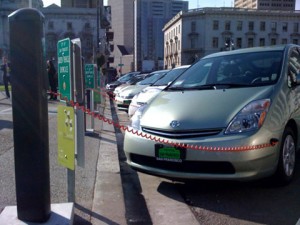
As people start ordering electric cars such as the Nissan Leaf, Tesla Roadster, and Chevy Volt, a vast network of charge points becomes more important. Drivers want to extend their range by hundreds of miles by charging at work, downtown, and on the road. Many who live in cities are interested in electric cars but do not have garages. They want work and public places to charge.
The automotive industry will reach a turning point during 2010, as it begins the gradual transition away from the internal combustion engine and towards electrification. According to a new report from Pike Research, this evolution will require a market-by-market expansion of electric vehicle (EV) charging infrastructure, ranging from residential equipment to public, private and workplace charging stations. The cleantech market intelligence firm forecasts that a total of 4.7 million such charge points will be installed worldwide during the period from 2010 to 2015. Electric Car Charging Articles.
Thousands of new charge points are now being installed. Ford is promoting smart charging as it now takes orders for the Ford Transit Connect, next year for the 2011 Ford Focus EV, and in 2012 the Ford Plug-in Hybrid. Ford is partnering with Coulomb Technologies to provide nearly 5,000 free wall-installed charging stations for some of the automaker’s first electric car and electric delivery van customers.
Pike forecasts that by 2015, more than 3.1 million EVs, including plug-in hybrids and all-electric vehicles, will be sold worldwide. Pike Research’s indicates that competition from infrastructure providers will intensify by the end of 2011. Leading the first 20,000 U.S. charge point installations are AeroVironment, Better Place, Coulomb Technologies, and ECOtality. GE, Panasonic, Samsung, and Siemens are moving into the space with hardware and network services.
Pike Research’s study, “Electric Vehicle Charging Equipment”, analyzes technology and expansion issues for the EV charging infrastructure in global markets. It examines the market for residential, public, private, and workplace charging stations as well as reviewing the key operational and technological impacts of plug-in hybrid and battery electric vehicles on the grid. Analysis includes an in-depth assessment of market drivers and barriers, along with profiles of charging infrastructure vendors and utilities. Detailed forecasts for EV charging equipment are included through 2015. A free Executive Summary is available online.
